Plastic Decking Market
Plastic Decking Market Size and Share Forecast Outlook 2025 to 2035
Plastic decking market is projected to grow from USD 6.4 billion in 2025 to USD 9.7 billion by 2035, at a CAGR of 4.2%. HDPE will dominate with a 50.0% market share, while residential will lead the application segment with a 65.0% share.
Plastic Decking Market Forecast and Outlook 2025 to 2035
The plastic decking market stands at the threshold of a decade-long expansion trajectory that promises to reshape outdoor construction technology and residential building solutions. The market's journey from USD 6,400.0 million in 2025 to USD 9,700.0 million by 2035 represents substantial growth, the market will rise at a CAGR of 4.2% which demonstrating the accelerating adoption of advanced decking materials and construction optimization across residential projects, commercial developments, and industrial facility sectors.
The first half of the decade (2025-2030) will witness the market climbing from USD 6,400.0 million to approximately USD 7,879.2 million, adding USD 1,479.2 million in value, which constitutes 45% of the total forecast growth period. This phase will be characterized by the rapid adoption of HDPE decking systems, driven by increasing residential construction volumes and the growing need for advanced outdoor building solutions worldwide. Enhanced durability capabilities and automated installation systems will become standard expectations rather than premium options.
The latter half (2030-2035) will witness continued growth from USD 7,879.2 million to USD 9,700.0 million, representing an addition of USD 1,820.8 million or 55% of the decade's expansion. This period will be defined by mass market penetration of composite decking technologies, integration with comprehensive building management platforms, and seamless compatibility with existing construction infrastructure. The market trajectory signals fundamental shifts in how construction facilities approach outdoor decking installation and maintenance management, with participants positioned to benefit from growing demand across multiple material types and application segments.
Quick Stats for Plastic Decking Market
- Plastic Decking Market Value (2025): USD 6,400.0 million
- Plastic Decking Market Forecast Value (2035): USD 9,700.0 million
- Plastic Decking Market Forecast CAGR: 4.2%
- Leading Product Type in Plastic Decking Market: HDPE
- Key Growth Regions in Plastic Decking Market: East Asia, North America, and Western Europe
- Top Players in Plastic Decking Market: Trex, TimberTech, Fiberon, MoistureShield, CertainTeed
- Where revenue comes from - Now Vs Next (Industry-level view)
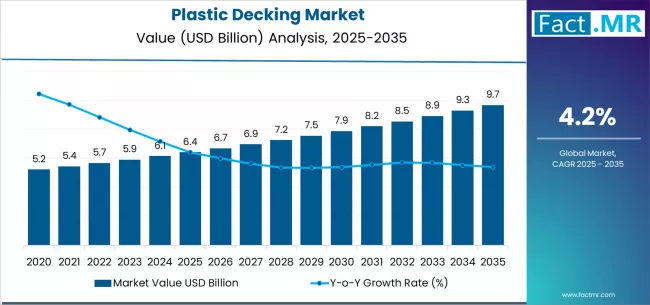
| Period | Primary Revenue Buckets | Share | Notes |
|---|---|---|---|
| Today | HDPE material systems | 50% | Volume-driven, residential-focused |
| PVC decking solutions | 30% | Commercial applications, durability emphasis | |
| Composite material products | 20% | Premium segments, enhanced aesthetics | |
| Future (3-5 yrs) | Advanced HDPE systems | 47-50% | Technology enhancement, performance gains |
| Enhanced PVC innovations | 28-32% | Commercial differentiation, application expansion | |
| Composite material solutions | 18-22% | Aesthetic improvements, premium positioning | |
| Smart decking integration | 5-8% | Digital monitoring, maintenance optimization | |
| Installation service solutions | 4-7% | Professional installation, warranty programs | |
| Maintenance and care products | 3-6% | Cleaning solutions, protection systems |
Plastic Decking Market Key Takeaways
At-a-Glance Metrics
| Metric | Value |
|---|---|
| Market Value (2025) → | USD 6,400.0 million |
| Market Forecast (2035) ↑ | USD 9,700.0 million |
| Growth Rate ★ | 4.2% CAGR |
| Leading Product → | HDPE |
| Primary Application → | Residential Segment |
The market demonstrates strong fundamentals with HDPE systems capturing a dominant share through advanced material properties and residential construction optimization. Residential applications drive primary demand, supported by increasing home improvement requirements and outdoor living space development. Geographic expansion remains concentrated in developed markets with established construction infrastructure, while emerging economies show accelerating adoption rates driven by residential development initiatives and rising construction standards.
Imperatives for Stakeholders in Plastic Decking Market
Design for installation simplicity, not just material performance
- Offer complete decking packages: material systems + installation guides + accessories + trained contractors + technical support.
- Preconfigured project solutions: material selection, color coordination, installation planning, and maintenance guidance for residential applications.
Material technology readiness
- Real-time performance monitoring analytics, weather resistance capabilities, and smart installation integration (material tracking, installation verification systems).
Quality-by-design approach
- Automated material quality systems, real-time durability testing, statistical performance control integration, and digital warranty documentation.
Value-based pricing models
- Clear base material price + transparent service tiers (installation support, design consultation, performance guarantees); subscriptions for maintenance services and performance analytics.
Segmental Analysis
Primary Classification: The market segments by type into HDPE, PVC, and composite materials, representing the evolution from basic plastic materials to specialized decking solutions for comprehensive outdoor construction and residential building optimization.
Secondary Classification: Application segmentation divides the market into residential (65.0%), commercial (25.0%), and industrial (10.0%) sectors, reflecting distinct requirements for home construction, business facility development, and industrial facility standards.
Tertiary Classification: Distribution channel segmentation covers retail (55.0%) and trade/contractor (45.0%) channels, demonstrating varied pathways for consumer purchase decisions and professional installation services.
The segmentation structure reveals technology progression from standard plastic materials toward specialized decking systems with enhanced durability and installation consistency, while application diversity spans from residential decking projects to commercial facilities requiring precise construction solutions.
By Type, the HDPE Segment Accounts for Dominant Market Share
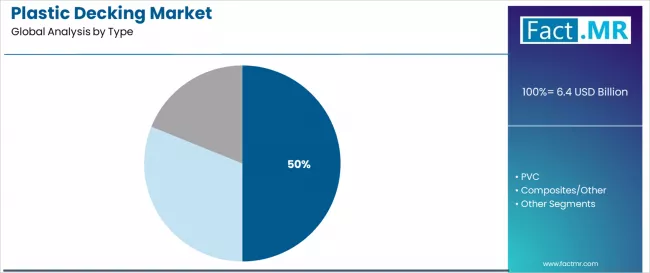
Market Position: HDPE systems command the leading position in the plastic decking market with 50% market share through advanced material features, including superior durability characteristics, weather resistance, and construction optimization that enable residential facilities to achieve optimal outdoor performance across diverse home construction and commercial applications.
Value Drivers: The segment benefits from construction facility preference for reliable decking systems that provide consistent performance characteristics, reduced maintenance complexity, and operational efficiency optimization without requiring significant installation modifications. Advanced material features enable automated quality control systems, durability consistency, and integration with existing construction equipment, where operational performance and building compliance represent critical facility requirements.
Competitive Advantages: HDPE systems differentiate through proven operational reliability, consistent material characteristics, and integration with automated construction systems that enhance facility effectiveness while maintaining optimal quality standards for diverse residential and commercial applications.
Key market characteristics:
- Advanced material designs with optimized durability configuration and weather resistance capabilities
- Enhanced construction effectiveness, enabling 20-25 year service life with reliable performance characteristics
- Residential construction compatibility, including automated installation systems, color coordination, and performance optimization for decking applications
PVC Systems Show Commercial Market Growth
PVC systems maintain a 30.0% market position in the plastic decking market due to their enhanced durability properties and commercial application characteristics. These systems appeal to facilities requiring specialized performance with premium positioning for commercial construction applications. Market growth is driven by commercial segment expansion, emphasizing durable decking solutions and operational efficiency through optimized material designs.
Composite Materials Maintain Premium Applications
Composite and other materials capture 20.0% market share through comprehensive aesthetic requirements in residential projects, premium installations, and specialty facilities. These solutions demand reliable material systems capable of operating with diverse design needs while providing effective performance characteristics and aesthetic appeal capabilities.
By Application, the Residential Segment Shows Market Leadership
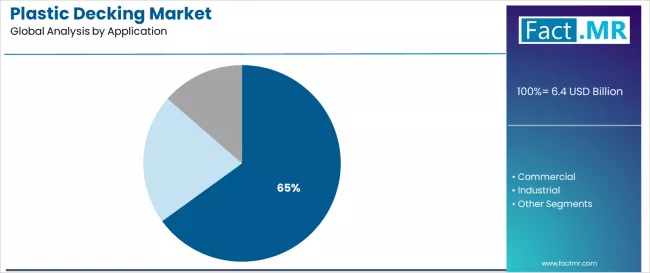
Market Context: Residential applications demonstrate market leadership in the plastic decking market with 65% share due to widespread adoption of decking systems and increasing focus on home improvement optimization, outdoor living enhancement, and property development applications that maximize home value while maintaining construction standards.
Appeal Factors: Residential operators prioritize material consistency, aesthetic appeal, and integration with existing home construction infrastructure that enables coordinated outdoor operations across multiple property installations. The segment benefits from substantial home improvement investment and modernization programs that emphasize the acquisition of advanced decking systems for outdoor optimization and property enhancement applications.
Growth Drivers: Home construction programs incorporate plastic decking as standard components for outdoor operations, while residential development growth increases demand for consistent material capabilities that comply with building standards and minimize maintenance complexity.
Application dynamics include:
- Strong growth in residential construction and home improvement requiring advanced decking capabilities
- Increasing adoption in outdoor optimization and property enhancement applications for homeowners
- Rising integration with automated construction systems for installation optimization and quality assurance
Commercial Applications Maintain Strong Demand
Commercial applications capture 25.0% market share through comprehensive facility requirements in office buildings, retail centers, and hospitality facilities. These facilities demand reliable decking systems capable of operating with diverse usage patterns while providing effective durability performance and aesthetic consistency capabilities.
Industrial Applications Show Specialized Growth
Industrial applications account for 10.0% market share, including manufacturing facilities, warehouses, and processing centers requiring efficient decking solutions for operational optimization and facility enhancement.
By Channel, the Retail Segment Shows Distribution Leadership
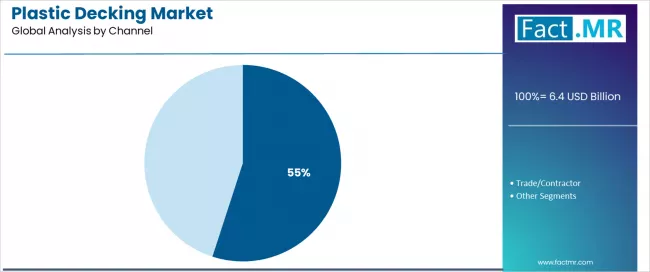
Retail channels demonstrate distribution leadership in the plastic decking market with 55% share due to widespread consumer access through home improvement stores and building supply retailers that maximize product availability while maintaining competitive pricing standards. Retail distribution appeals to residential consumers seeking direct purchase options with immediate availability characteristics.
Trade and Contractor Channels Maintain Professional Market
Trade and contractor channels capture 45.0% market share through comprehensive professional requirements in construction projects, commercial installations, and specialty applications requiring contractor expertise and bulk purchasing capabilities.
What are the Drivers, Restraints, and Key Trends of the Plastic Decking Market?
| Category | Factor | Impact | Why It Matters |
|---|---|---|---|
| Driver | Residential construction growth & outdoor living trends (home improvement focus, property value enhancement) | ★★★★★ | Large-scale residential development requires durable, low-maintenance decking solutions with consistent quality and aesthetic performance across construction applications. |
| Driver | Low maintenance requirements & durability advantages | ★★★★★ | Drives demand for long-lasting material solutions and reduced upkeep capabilities; suppliers providing maintenance benefits gain competitive advantage. |
| Driver | Weather resistance & climate adaptability | ★★★★☆ | Construction facilities need reliable, weather-resistant decking solutions; demand for climate-adapted formats expanding addressable market segments. |
| Restraint | Raw material price volatility & polymer cost fluctuations | ★★★★☆ | Small manufacturers face margin pressure; increases cost sensitivity and affects production consistency in volatile material markets. |
| Restraint | Installation complexity & contractor availability | ★★★☆☆ | Quality-focused applications face challenges with professional installation and contractor requirements, limiting adoption in cost-sensitive segments. |
| Trend | Composite material innovation & aesthetic enhancement | ★★★★★ | Growing demand for visually appealing decking applications; aesthetic compatibility becomes core value proposition in premium residential segments. |
| Trend | Asian market expansion & manufacturing development | ★★★★☆ | Regional construction development drives demand for local decking solutions; regional manufacturing capabilities drive competition toward localization. |
Analysis of the Plastic Decking Market by Key Country
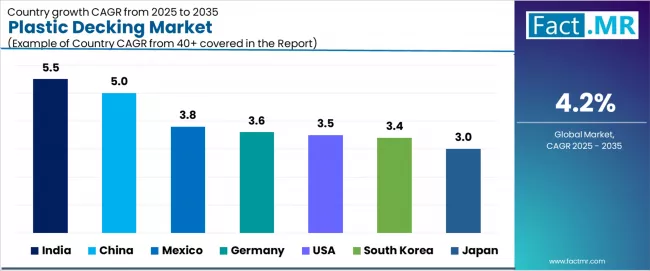
The plastic decking market demonstrates varied regional dynamics with growth leaders including India (5.5% growth rate) and China (5.0% growth rate) driving expansion through construction development initiatives and residential building modernization. Steady Performers encompass Mexico (3.8% growth rate), Germany (3.6% growth rate), and United States (3.5% growth rate), benefiting from established construction industries and advanced material adoption. Mature Markets feature South Korea (3.4% growth rate) and Japan (3.0% growth rate), where construction technology advancement and quality standardization requirements support consistent growth patterns.
Regional synthesis reveals South Asian and East Asian markets leading adoption through construction expansion and residential development, while Western countries maintain steady expansion supported by technology advancement and building standardization requirements. Emerging markets show strong growth driven by residential applications and construction integration trends.
| Region/Country | 2025-2035 Growth | How to win | What to watch out |
|---|---|---|---|
| India | 5.5% | Focus on cost-effective residential solutions | Supply chain challenges; quality standardization |
| China | 5.0% | Lead with high-volume production systems | Environmental regulations; material costs |
| Mexico | 3.8% | Value-oriented construction models | Currency fluctuations; trade regulations |
| Germany | 3.6% | Offer premium quality systems | Over-engineering; building code compliance |
| United States | 3.5% | Provide complete system solutions | Installation requirements; contractor availability |
| South Korea | 3.4% | Push residential integration | Market saturation; construction costs |
| Japan | 3.0% | Premium quality positioning | Material precision; market maturity |
India Drives Fastest Market Growth
India establishes fastest market growth through aggressive residential construction programs and comprehensive home development expansion, integrating advanced plastic decking as standard components in residential projects and building installations. The country's 5.5% growth rate reflects government initiatives promoting housing development and residential modernization capabilities that mandate the use of advanced construction materials in residential facilities. Growth concentrates in major urban centers, including Mumbai, Delhi, and Bangalore, where residential development showcases integrated decking systems that appeal to developers seeking advanced construction optimization capabilities and property enhancement applications.
Indian manufacturers are developing cost-effective decking solutions that combine domestic production advantages with advanced material features, including weather resistance and enhanced durability capabilities. Distribution channels through building material dealers and construction service providers expand market access, while government support for housing development supports adoption across diverse residential segments.
Strategic Market Indicators:
- Residential facilities leading adoption with 72% deployment rate in plastic decking and home construction sectors
- Government housing programs providing substantial funding for domestic construction material development
- Local manufacturers capturing 45% market share through competitive pricing and localized material support
- Export market development for cost-effective decking solutions targeting emerging construction markets
China Emerges as High-Volume Market
In Guangdong, Shanghai, and Beijing regions, construction facilities and residential developments are implementing advanced plastic decking as standard materials for building optimization and property enhancement, driven by increasing government construction investment and residential infrastructure modernization programs that emphasize the importance of decking material capabilities. The market holds a 5.0% growth rate, supported by government development initiatives and construction infrastructure programs that promote advanced decking systems for residential facilities. Chinese operators are adopting decking systems that provide consistent material performance and quality compliance features, particularly appealing in urban regions where construction standards and building efficiency represent critical operational requirements.
Market expansion benefits from growing construction capabilities and manufacturing integration agreements that enable domestic production of advanced decking systems for residential applications. Technology adoption follows patterns established in construction materials, where durability and performance drive procurement decisions and project deployment.
Mexico Shows Strong Regional Leadership
Plastic decking market expansion in Mexico benefits from diverse residential construction demand, including housing modernization in Mexico City and Guadalajara, facility upgrades, and government housing programs that increasingly incorporate decking solutions for construction optimization applications. The country maintains a 3.8% growth rate, driven by rising residential activity and increasing recognition of decking benefits, including enhanced durability and improved property aesthetics.
Market dynamics focus on cost-effective decking solutions that balance advanced material performance with affordability considerations important to Mexican builders. Growing residential industrialization creates continued demand for modern decking systems in new construction infrastructure and housing modernization projects.
Germany Shows Technology Leadership
Advanced construction technology market in Germany demonstrates sophisticated plastic decking deployment with documented operational effectiveness in residential applications and commercial facilities through integration with existing building systems and construction infrastructure. The country leverages engineering expertise in material technology and quality systems integration to maintain a 3.6% growth rate. Construction centers, including North Rhine-Westphalia, Bavaria, and Baden-Württemberg, showcase premium installations where decking systems integrate with comprehensive building platforms and facility management systems to optimize construction operations and material effectiveness.
German manufacturers prioritize system precision and EU compliance in material development, creating demand for premium systems with advanced features, including building integration and automated quality systems. The market benefits from established construction infrastructure and willingness to invest in advanced material technologies that provide long-term operational benefits and compliance with international building standards.
United States Shows Market Innovation
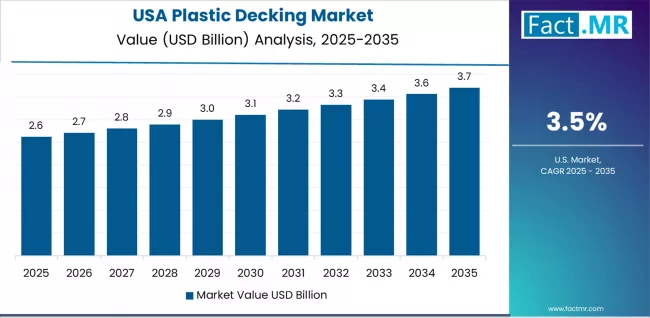
United States establishes market innovation through comprehensive residential construction and established building infrastructure, integrating plastic decking across residential facilities and commercial construction applications. The country's 3.5% growth rate reflects mature construction industry relationships and established decking adoption that supports widespread use of material systems in residential and commercial facilities. Growth concentrates in major construction centers, including Texas, California, and Florida, where construction technology showcases mature decking deployment that appeals to builders seeking proven construction capabilities and operational efficiency applications.
American operators leverage established distribution networks and comprehensive construction capabilities, including installation services and technical support that create customer relationships and operational advantages. The market benefits from mature building standards and construction requirements that mandate decking system use while supporting technology advancement and operational optimization.
South Korea Shows Residential Integration
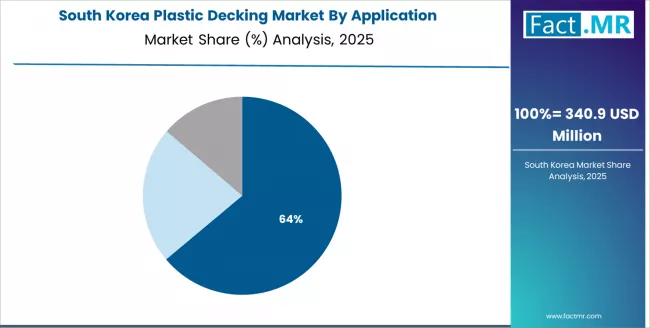
South Korea establishes residential integration through comprehensive construction modernization and building infrastructure development, integrating plastic decking systems across residential facilities and modern construction applications. The country's 3.4% growth rate reflects growing construction investment and increasing adoption of decking technology that supports expanding use of material systems in Korean residential facilities. Growth concentrates in major urban areas, including Seoul metropolitan area, Busan, and Daegu, where construction development showcases integrated decking systems that appeal to Korean builders seeking advanced residential solutions with material compatibility.
Korean operators focus on maintaining construction standards while adopting building efficiency, creating demand for systems that balance performance with operational advantages. The market benefits from strong construction infrastructure and growing residential opportunities that support decking technology adoption while maintaining building standards important to Korean construction applications.
Japan Demonstrates Premium Quality Focus
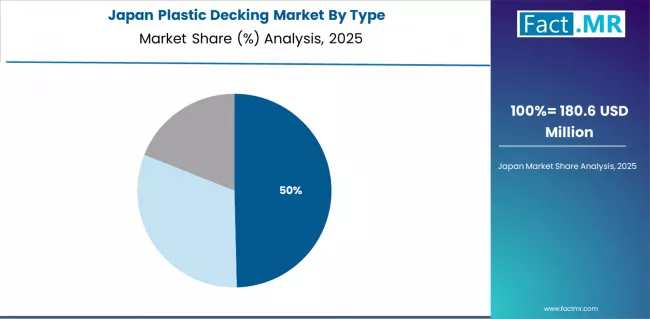
Advanced construction technology market in Japan demonstrates sophisticated plastic decking deployment with documented operational effectiveness in premium residential applications and modern construction facilities through integration with existing building systems and construction infrastructure. The country maintains a 3.0% growth rate, leveraging traditional quality expertise and precision systems integration in material technology. Construction centers, including Tokyo, Osaka, and Nagoya, showcase premium installations where decking systems integrate with traditional quality platforms and modern building management systems to optimize construction operations and maintain material quality profiles.
Japanese manufacturers prioritize material precision and quality consistency in decking development, creating demand for premium systems with advanced features, including quality monitoring and automated construction systems. The market benefits from established quality infrastructure and commitment to construction standards that provide long-term operational benefits and compliance with traditional quality construction methods.
Europe Market Split by Country
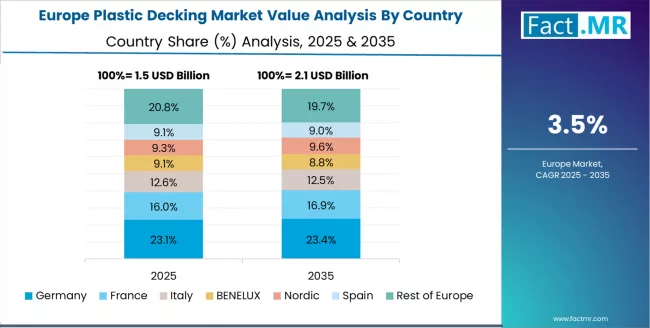
The European plastic decking market is projected to grow from USD 6,400.0 million in 2025, representing 100% of the analyzed market, with strong regional distribution across major economies. Germany is expected to maintain its leadership position with USD 1,500.0 million in 2025, accounting for 23.4% of the European market, supported by its advanced construction infrastructure and major residential centers.
United Kingdom follows with USD 1,100.0 million, representing 17.2% of the European market in 2025, driven by comprehensive residential construction programs and building modernization initiatives. France holds USD 850.0 million with 13.3% market share through specialized construction applications and building requirements. Italy commands USD 650.0 million representing 10.2% share, while Spain accounts for USD 520.0 million or 8.1% in 2025. The rest of Europe region maintains USD 1,780.0 million, representing 27.8% of the European market, attributed to increasing decking adoption in Nordic countries and emerging construction facilities implementing building modernization programs.
Competitive Landscape of the Plastic Decking Market
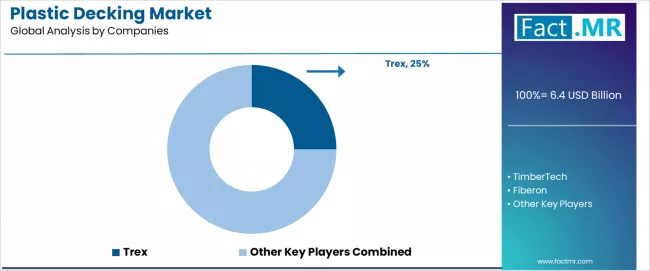
- Structure: ~18-22 credible players; top 5-7 hold ~40-45% by revenue.
- Leadership is maintained through: brand recognition, material innovation, and distribution control (durability retention + aesthetic appeal + installation support).
- What's commoditizing: basic HDPE materials and standard color options.
- Margin Opportunities: premium composite solutions, installation services, and integrated building solutions (design consultation, maintenance programs).
| Stakeholder | What they actually control | Typical strengths | Typical blind spots |
|---|---|---|---|
| Established brands | Brand reputation, premium positioning, retail relationships | Market recognition, proven durability, comprehensive warranties | Price competition; emerging market penetration |
| Material innovators | R&D capabilities; advanced composites; aesthetic development | Latest materials first; attractive performance on premium applications | Cost competitiveness; mass market scalability |
| Regional manufacturers | Local production, competitive pricing, regional distribution | Cost advantages, local preferences, faster delivery | Brand building; premium segment access |
| Integrated solutions | Complete systems, installation services, project management | End-to-end solutions; contractor relationships; project expertise | Material specialization; manufacturing efficiency |
| Specialty producers | Niche applications, custom colors, specialized materials | Unique offerings; premium pricing; technical expertise | Volume limitations; broad market appeal |
Key Players in the Plastic Decking Market
- Trex
- TimberTech
- Fiberon
- MoistureShield
- CertainTeed
- Universal Forest
- UPM
- Eva-Last
- Green Bay Decking
- Advanced Environmental
- NewTechWood
- Cali-Bamboo
- DuraLife
- Lumberock
- Nexan
Scope of the Report
| Items | Values |
|---|---|
| Quantitative Units (2025) | USD 6,400.0 million |
| Type | HDPE, PVC, Composites/Other |
| Application | Residential, Commercial, Industrial |
| Channel | Retail, Trade/Contractor |
| Regions Covered | East Asia, Western Europe, North America, South Asia Pacific, Latin America, Middle East & Africa |
| Countries Covered | China, United States, Germany, Japan, India, South Korea, Mexico, United Kingdom, France, and 30+ additional countries |
| Key Companies Profiled | Trex, TimberTech, Fiberon, MoistureShield, CertainTeed, Universal Forest, UPM, Eva-Last, Green Bay Decking, Advanced Environmental |
| Additional Attributes | Dollar sales by material type, application categories, and distribution channels, regional adoption trends across East Asia, Western Europe, and North America, competitive landscape with material manufacturers and construction suppliers, builder preferences for material consistency and installation reliability, integration with construction platforms and building management systems, innovations in material technology and performance enhancement, and development of advanced decking solutions with enhanced durability and construction optimization capabilities. |
Plastic Decking Market by Segments
-
Type :
- HDPE
- PVC
- Composites/Other
-
Application :
- Residential
- Commercial
- Industrial
-
Channel :
- Retail
- Trade/Contractor
-
Region :
- East Asia
- China
- Japan
- South Korea
- South Asia Pacific
- India
- ASEAN
- Australia & New Zealand
- Rest of South Asia Pacific
- Western Europe
- Germany
- United Kingdom
- France
- Italy
- Spain
- Rest of Western Europe
- North America
- United States
- Canada
- Mexico
- Latin America
- Brazil
- Rest of Latin America
- Middle East & Africa
- GCC Countries
- South Africa
- Rest of Middle East & Africa
- East Asia
Table of Content
- Executive Summary
- Global Market Outlook
- Demand to side Trends
- Supply to side Trends
- Technology Roadmap Analysis
- Analysis and Recommendations
- Market Overview
- Market Coverage / Taxonomy
- Market Definition / Scope / Limitations
- Market Background
- Market Dynamics
- Drivers
- Restraints
- Opportunity
- Trends
- Scenario Forecast
- Demand in Optimistic Scenario
- Demand in Likely Scenario
- Demand in Conservative Scenario
- Opportunity Map Analysis
- Product Life Cycle Analysis
- Supply Chain Analysis
- Investment Feasibility Matrix
- Value Chain Analysis
- PESTLE and Porter’s Analysis
- Regulatory Landscape
- Regional Parent Market Outlook
- Production and Consumption Statistics
- Import and Export Statistics
- Market Dynamics
- Global Market Analysis 2020 to 2024 and Forecast, 2025 to 2035
- Historical Market Size Value (USD Million) Analysis, 2020 to 2024
- Current and Future Market Size Value (USD Million) Projections, 2025 to 2035
- Y to o to Y Growth Trend Analysis
- Absolute $ Opportunity Analysis
- Global Market Pricing Analysis 2020 to 2024 and Forecast 2025 to 2035
- Global Market Analysis 2020 to 2024 and Forecast 2025 to 2035, By Type
- Introduction / Key Findings
- Historical Market Size Value (USD Million) Analysis By Type , 2020 to 2024
- Current and Future Market Size Value (USD Million) Analysis and Forecast By Type , 2025 to 2035
- HDPE
- PVC
- Composites/Other
- Y to o to Y Growth Trend Analysis By Type , 2020 to 2024
- Absolute $ Opportunity Analysis By Type , 2025 to 2035
- Global Market Analysis 2020 to 2024 and Forecast 2025 to 2035, By Application
- Introduction / Key Findings
- Historical Market Size Value (USD Million) Analysis By Application, 2020 to 2024
- Current and Future Market Size Value (USD Million) Analysis and Forecast By Application, 2025 to 2035
- Residential
- Commercial
- Industrial
- Y to o to Y Growth Trend Analysis By Application, 2020 to 2024
- Absolute $ Opportunity Analysis By Application, 2025 to 2035
- Global Market Analysis 2020 to 2024 and Forecast 2025 to 2035, By Channel
- Introduction / Key Findings
- Historical Market Size Value (USD Million) Analysis By Channel, 2020 to 2024
- Current and Future Market Size Value (USD Million) Analysis and Forecast By Channel, 2025 to 2035
- Retail channels
- Trade/Contractor
- Y to o to Y Growth Trend Analysis By Channel, 2020 to 2024
- Absolute $ Opportunity Analysis By Channel, 2025 to 2035
- Global Market Analysis 2020 to 2024 and Forecast 2025 to 2035, By Region
- Introduction
- Historical Market Size Value (USD Million) Analysis By Region, 2020 to 2024
- Current Market Size Value (USD Million) Analysis and Forecast By Region, 2025 to 2035
- North America
- Latin America
- Western Europe
- Eastern Europe
- East Asia
- South Asia and Pacific
- Middle East & Africa
- Market Attractiveness Analysis By Region
- North America Market Analysis 2020 to 2024 and Forecast 2025 to 2035, By Country
- Historical Market Size Value (USD Million) Trend Analysis By Market Taxonomy, 2020 to 2024
- Market Size Value (USD Million) Forecast By Market Taxonomy, 2025 to 2035
- By Country
- USA
- Canada
- Mexico
- By Type
- By Application
- By Channel
- By Country
- Market Attractiveness Analysis
- By Country
- By Type
- By Application
- By Channel
- Key Takeaways
- Latin America Market Analysis 2020 to 2024 and Forecast 2025 to 2035, By Country
- Historical Market Size Value (USD Million) Trend Analysis By Market Taxonomy, 2020 to 2024
- Market Size Value (USD Million) Forecast By Market Taxonomy, 2025 to 2035
- By Country
- Brazil
- Chile
- Rest of Latin America
- By Type
- By Application
- By Channel
- By Country
- Market Attractiveness Analysis
- By Country
- By Type
- By Application
- By Channel
- Key Takeaways
- Western Europe Market Analysis 2020 to 2024 and Forecast 2025 to 2035, By Country
- Historical Market Size Value (USD Million) Trend Analysis By Market Taxonomy, 2020 to 2024
- Market Size Value (USD Million) Forecast By Market Taxonomy, 2025 to 2035
- By Country
- Germany
- UK
- Italy
- Spain
- France
- Nordic
- BENELUX
- Rest of Western Europe
- By Type
- By Application
- By Channel
- By Country
- Market Attractiveness Analysis
- By Country
- By Type
- By Application
- By Channel
- Key Takeaways
- Eastern Europe Market Analysis 2020 to 2024 and Forecast 2025 to 2035, By Country
- Historical Market Size Value (USD Million) Trend Analysis By Market Taxonomy, 2020 to 2024
- Market Size Value (USD Million) Forecast By Market Taxonomy, 2025 to 2035
- By Country
- Russia
- Poland
- Hungary
- Balkan & Baltic
- Rest of Eastern Europe
- By Type
- By Application
- By Channel
- By Country
- Market Attractiveness Analysis
- By Country
- By Type
- By Application
- By Channel
- Key Takeaways
- East Asia Market Analysis 2020 to 2024 and Forecast 2025 to 2035, By Country
- Historical Market Size Value (USD Million) Trend Analysis By Market Taxonomy, 2020 to 2024
- Market Size Value (USD Million) Forecast By Market Taxonomy, 2025 to 2035
- By Country
- China
- Japan
- South Korea
- By Type
- By Application
- By Channel
- By Country
- Market Attractiveness Analysis
- By Country
- By Type
- By Application
- By Channel
- Key Takeaways
- South Asia and Pacific Market Analysis 2020 to 2024 and Forecast 2025 to 2035, By Country
- Historical Market Size Value (USD Million) Trend Analysis By Market Taxonomy, 2020 to 2024
- Market Size Value (USD Million) Forecast By Market Taxonomy, 2025 to 2035
- By Country
- India
- ASEAN
- Australia & New Zealand
- Rest of South Asia and Pacific
- By Type
- By Application
- By Channel
- By Country
- Market Attractiveness Analysis
- By Country
- By Type
- By Application
- By Channel
- Key Takeaways
- Middle East & Africa Market Analysis 2020 to 2024 and Forecast 2025 to 2035, By Country
- Historical Market Size Value (USD Million) Trend Analysis By Market Taxonomy, 2020 to 2024
- Market Size Value (USD Million) Forecast By Market Taxonomy, 2025 to 2035
- By Country
- Kingdom of Saudi Arabia
- Other GCC Countries
- Turkiye
- South Africa
- Other African Union
- Rest of Middle East & Africa
- By Type
- By Application
- By Channel
- By Country
- Market Attractiveness Analysis
- By Country
- By Type
- By Application
- By Channel
- Key Takeaways
- Key Countries Market Analysis
- USA
- Pricing Analysis
- Market Share Analysis, 2024
- By Type
- By Application
- By Channel
- Canada
- Pricing Analysis
- Market Share Analysis, 2024
- By Type
- By Application
- By Channel
- Mexico
- Pricing Analysis
- Market Share Analysis, 2024
- By Type
- By Application
- By Channel
- Brazil
- Pricing Analysis
- Market Share Analysis, 2024
- By Type
- By Application
- By Channel
- Chile
- Pricing Analysis
- Market Share Analysis, 2024
- By Type
- By Application
- By Channel
- Germany
- Pricing Analysis
- Market Share Analysis, 2024
- By Type
- By Application
- By Channel
- UK
- Pricing Analysis
- Market Share Analysis, 2024
- By Type
- By Application
- By Channel
- Italy
- Pricing Analysis
- Market Share Analysis, 2024
- By Type
- By Application
- By Channel
- Spain
- Pricing Analysis
- Market Share Analysis, 2024
- By Type
- By Application
- By Channel
- France
- Pricing Analysis
- Market Share Analysis, 2024
- By Type
- By Application
- By Channel
- India
- Pricing Analysis
- Market Share Analysis, 2024
- By Type
- By Application
- By Channel
- ASEAN
- Pricing Analysis
- Market Share Analysis, 2024
- By Type
- By Application
- By Channel
- Australia & New Zealand
- Pricing Analysis
- Market Share Analysis, 2024
- By Type
- By Application
- By Channel
- China
- Pricing Analysis
- Market Share Analysis, 2024
- By Type
- By Application
- By Channel
- Japan
- Pricing Analysis
- Market Share Analysis, 2024
- By Type
- By Application
- By Channel
- South Korea
- Pricing Analysis
- Market Share Analysis, 2024
- By Type
- By Application
- By Channel
- Russia
- Pricing Analysis
- Market Share Analysis, 2024
- By Type
- By Application
- By Channel
- Poland
- Pricing Analysis
- Market Share Analysis, 2024
- By Type
- By Application
- By Channel
- Hungary
- Pricing Analysis
- Market Share Analysis, 2024
- By Type
- By Application
- By Channel
- Kingdom of Saudi Arabia
- Pricing Analysis
- Market Share Analysis, 2024
- By Type
- By Application
- By Channel
- Turkiye
- Pricing Analysis
- Market Share Analysis, 2024
- By Type
- By Application
- By Channel
- South Africa
- Pricing Analysis
- Market Share Analysis, 2024
- By Type
- By Application
- By Channel
- USA
- Market Structure Analysis
- Competition Dashboard
- Competition Benchmarking
- Market Share Analysis of Top Players
- By Regional
- By Type
- By Application
- By Channel
- Competition Analysis
- Competition Deep Dive
- Trex
- Overview
- Product Portfolio
- Profitability by Market Segments (Product/Age /Sales Channel/Region)
- Sales Footprint
- Strategy Overview
- Marketing Strategy
- Product Strategy
- Channel Strategy
- TimberTech
- Fiberon
- MoistureShield
- CertainTeed
- Universal Forest
- UPM
- Eva-Last
- Green Bay Decking
- Advanced Environmental
- NewTechWood
- Cali-Bamboo
- DuraLife
- Lumberock
- Nexan
- Trex
- Competition Deep Dive
- Assumptions & Acronyms Used
- Research Methodology
List Of Table
- Table 1: Global Market Value (USD Million) Forecast by Region, 2020 to 2035
- Table 2: Global Market Value (USD Million) Forecast by Type , 2020 to 2035
- Table 3: Global Market Value (USD Million) Forecast by Application, 2020 to 2035
- Table 4: Global Market Value (USD Million) Forecast by Channel, 2020 to 2035
- Table 5: North America Market Value (USD Million) Forecast by Country, 2020 to 2035
- Table 6: North America Market Value (USD Million) Forecast by Type , 2020 to 2035
- Table 7: North America Market Value (USD Million) Forecast by Application, 2020 to 2035
- Table 8: North America Market Value (USD Million) Forecast by Channel, 2020 to 2035
- Table 9: Latin America Market Value (USD Million) Forecast by Country, 2020 to 2035
- Table 10: Latin America Market Value (USD Million) Forecast by Type , 2020 to 2035
- Table 11: Latin America Market Value (USD Million) Forecast by Application, 2020 to 2035
- Table 12: Latin America Market Value (USD Million) Forecast by Channel, 2020 to 2035
- Table 13: Western Europe Market Value (USD Million) Forecast by Country, 2020 to 2035
- Table 14: Western Europe Market Value (USD Million) Forecast by Type , 2020 to 2035
- Table 15: Western Europe Market Value (USD Million) Forecast by Application, 2020 to 2035
- Table 16: Western Europe Market Value (USD Million) Forecast by Channel, 2020 to 2035
- Table 17: Eastern Europe Market Value (USD Million) Forecast by Country, 2020 to 2035
- Table 18: Eastern Europe Market Value (USD Million) Forecast by Type , 2020 to 2035
- Table 19: Eastern Europe Market Value (USD Million) Forecast by Application, 2020 to 2035
- Table 20: Eastern Europe Market Value (USD Million) Forecast by Channel, 2020 to 2035
- Table 21: East Asia Market Value (USD Million) Forecast by Country, 2020 to 2035
- Table 22: East Asia Market Value (USD Million) Forecast by Type , 2020 to 2035
- Table 23: East Asia Market Value (USD Million) Forecast by Application, 2020 to 2035
- Table 24: East Asia Market Value (USD Million) Forecast by Channel, 2020 to 2035
- Table 25: South Asia and Pacific Market Value (USD Million) Forecast by Country, 2020 to 2035
- Table 26: South Asia and Pacific Market Value (USD Million) Forecast by Type , 2020 to 2035
- Table 27: South Asia and Pacific Market Value (USD Million) Forecast by Application, 2020 to 2035
- Table 28: South Asia and Pacific Market Value (USD Million) Forecast by Channel, 2020 to 2035
- Table 29: Middle East & Africa Market Value (USD Million) Forecast by Country, 2020 to 2035
- Table 30: Middle East & Africa Market Value (USD Million) Forecast by Type , 2020 to 2035
- Table 31: Middle East & Africa Market Value (USD Million) Forecast by Application, 2020 to 2035
- Table 32: Middle East & Africa Market Value (USD Million) Forecast by Channel, 2020 to 2035
List Of Figures
- Figure 1: Global Market Pricing Analysis
- Figure 2: Global Market Value (USD Million) Forecast 2020-2035
- Figure 3: Global Market Value Share and BPS Analysis by Type , 2025 and 2035
- Figure 4: Global Market Y to o to Y Growth Comparison by Type , 2025-2035
- Figure 5: Global Market Attractiveness Analysis by Type
- Figure 6: Global Market Value Share and BPS Analysis by Application, 2025 and 2035
- Figure 7: Global Market Y to o to Y Growth Comparison by Application, 2025-2035
- Figure 8: Global Market Attractiveness Analysis by Application
- Figure 9: Global Market Value Share and BPS Analysis by Channel, 2025 and 2035
- Figure 10: Global Market Y to o to Y Growth Comparison by Channel, 2025-2035
- Figure 11: Global Market Attractiveness Analysis by Channel
- Figure 12: Global Market Value (USD Million) Share and BPS Analysis by Region, 2025 and 2035
- Figure 13: Global Market Y to o to Y Growth Comparison by Region, 2025-2035
- Figure 14: Global Market Attractiveness Analysis by Region
- Figure 15: North America Market Incremental Dollar Opportunity, 2025-2035
- Figure 16: Latin America Market Incremental Dollar Opportunity, 2025-2035
- Figure 17: Western Europe Market Incremental Dollar Opportunity, 2025-2035
- Figure 18: Eastern Europe Market Incremental Dollar Opportunity, 2025-2035
- Figure 19: East Asia Market Incremental Dollar Opportunity, 2025-2035
- Figure 20: South Asia and Pacific Market Incremental Dollar Opportunity, 2025-2035
- Figure 21: Middle East & Africa Market Incremental Dollar Opportunity, 2025-2035
- Figure 22: North America Market Value Share and BPS Analysis by Country, 2025 and 2035
- Figure 23: North America Market Value Share and BPS Analysis by Type , 2025 and 2035
- Figure 24: North America Market Y to o to Y Growth Comparison by Type , 2025-2035
- Figure 25: North America Market Attractiveness Analysis by Type
- Figure 26: North America Market Value Share and BPS Analysis by Application, 2025 and 2035
- Figure 27: North America Market Y to o to Y Growth Comparison by Application, 2025-2035
- Figure 28: North America Market Attractiveness Analysis by Application
- Figure 29: North America Market Value Share and BPS Analysis by Channel, 2025 and 2035
- Figure 30: North America Market Y to o to Y Growth Comparison by Channel, 2025-2035
- Figure 31: North America Market Attractiveness Analysis by Channel
- Figure 32: Latin America Market Value Share and BPS Analysis by Country, 2025 and 2035
- Figure 33: Latin America Market Value Share and BPS Analysis by Type , 2025 and 2035
- Figure 34: Latin America Market Y to o to Y Growth Comparison by Type , 2025-2035
- Figure 35: Latin America Market Attractiveness Analysis by Type
- Figure 36: Latin America Market Value Share and BPS Analysis by Application, 2025 and 2035
- Figure 37: Latin America Market Y to o to Y Growth Comparison by Application, 2025-2035
- Figure 38: Latin America Market Attractiveness Analysis by Application
- Figure 39: Latin America Market Value Share and BPS Analysis by Channel, 2025 and 2035
- Figure 40: Latin America Market Y to o to Y Growth Comparison by Channel, 2025-2035
- Figure 41: Latin America Market Attractiveness Analysis by Channel
- Figure 42: Western Europe Market Value Share and BPS Analysis by Country, 2025 and 2035
- Figure 43: Western Europe Market Value Share and BPS Analysis by Type , 2025 and 2035
- Figure 44: Western Europe Market Y to o to Y Growth Comparison by Type , 2025-2035
- Figure 45: Western Europe Market Attractiveness Analysis by Type
- Figure 46: Western Europe Market Value Share and BPS Analysis by Application, 2025 and 2035
- Figure 47: Western Europe Market Y to o to Y Growth Comparison by Application, 2025-2035
- Figure 48: Western Europe Market Attractiveness Analysis by Application
- Figure 49: Western Europe Market Value Share and BPS Analysis by Channel, 2025 and 2035
- Figure 50: Western Europe Market Y to o to Y Growth Comparison by Channel, 2025-2035
- Figure 51: Western Europe Market Attractiveness Analysis by Channel
- Figure 52: Eastern Europe Market Value Share and BPS Analysis by Country, 2025 and 2035
- Figure 53: Eastern Europe Market Value Share and BPS Analysis by Type , 2025 and 2035
- Figure 54: Eastern Europe Market Y to o to Y Growth Comparison by Type , 2025-2035
- Figure 55: Eastern Europe Market Attractiveness Analysis by Type
- Figure 56: Eastern Europe Market Value Share and BPS Analysis by Application, 2025 and 2035
- Figure 57: Eastern Europe Market Y to o to Y Growth Comparison by Application, 2025-2035
- Figure 58: Eastern Europe Market Attractiveness Analysis by Application
- Figure 59: Eastern Europe Market Value Share and BPS Analysis by Channel, 2025 and 2035
- Figure 60: Eastern Europe Market Y to o to Y Growth Comparison by Channel, 2025-2035
- Figure 61: Eastern Europe Market Attractiveness Analysis by Channel
- Figure 62: East Asia Market Value Share and BPS Analysis by Country, 2025 and 2035
- Figure 63: East Asia Market Value Share and BPS Analysis by Type , 2025 and 2035
- Figure 64: East Asia Market Y to o to Y Growth Comparison by Type , 2025-2035
- Figure 65: East Asia Market Attractiveness Analysis by Type
- Figure 66: East Asia Market Value Share and BPS Analysis by Application, 2025 and 2035
- Figure 67: East Asia Market Y to o to Y Growth Comparison by Application, 2025-2035
- Figure 68: East Asia Market Attractiveness Analysis by Application
- Figure 69: East Asia Market Value Share and BPS Analysis by Channel, 2025 and 2035
- Figure 70: East Asia Market Y to o to Y Growth Comparison by Channel, 2025-2035
- Figure 71: East Asia Market Attractiveness Analysis by Channel
- Figure 72: South Asia and Pacific Market Value Share and BPS Analysis by Country, 2025 and 2035
- Figure 73: South Asia and Pacific Market Value Share and BPS Analysis by Type , 2025 and 2035
- Figure 74: South Asia and Pacific Market Y to o to Y Growth Comparison by Type , 2025-2035
- Figure 75: South Asia and Pacific Market Attractiveness Analysis by Type
- Figure 76: South Asia and Pacific Market Value Share and BPS Analysis by Application, 2025 and 2035
- Figure 77: South Asia and Pacific Market Y to o to Y Growth Comparison by Application, 2025-2035
- Figure 78: South Asia and Pacific Market Attractiveness Analysis by Application
- Figure 79: South Asia and Pacific Market Value Share and BPS Analysis by Channel, 2025 and 2035
- Figure 80: South Asia and Pacific Market Y to o to Y Growth Comparison by Channel, 2025-2035
- Figure 81: South Asia and Pacific Market Attractiveness Analysis by Channel
- Figure 82: Middle East & Africa Market Value Share and BPS Analysis by Country, 2025 and 2035
- Figure 83: Middle East & Africa Market Value Share and BPS Analysis by Type , 2025 and 2035
- Figure 84: Middle East & Africa Market Y to o to Y Growth Comparison by Type , 2025-2035
- Figure 85: Middle East & Africa Market Attractiveness Analysis by Type
- Figure 86: Middle East & Africa Market Value Share and BPS Analysis by Application, 2025 and 2035
- Figure 87: Middle East & Africa Market Y to o to Y Growth Comparison by Application, 2025-2035
- Figure 88: Middle East & Africa Market Attractiveness Analysis by Application
- Figure 89: Middle East & Africa Market Value Share and BPS Analysis by Channel, 2025 and 2035
- Figure 90: Middle East & Africa Market Y to o to Y Growth Comparison by Channel, 2025-2035
- Figure 91: Middle East & Africa Market Attractiveness Analysis by Channel
- Figure 92: Global Market - Tier Structure Analysis
- Figure 93: Global Market - Company Share Analysis
- FAQs -
How big is the plastic decking market in 2025?
The global plastic decking market is estimated to be valued at USD 6.4 billion in 2025.
What will be the size of plastic decking market in 2035?
The market size for the plastic decking market is projected to reach USD 9.7 billion by 2035.
How much will be the plastic decking market growth between 2025 and 2035?
The plastic decking market is expected to grow at a 4.2% CAGR between 2025 and 2035.
What are the key product types in the plastic decking market?
The key product types in plastic decking market are hdpe, pvc and composites/other.
Which application segment to contribute significant share in the plastic decking market in 2025?
In terms of application, residential segment to command 65.0% share in the plastic decking market in 2025.